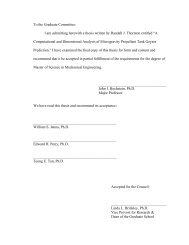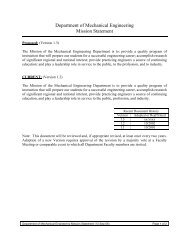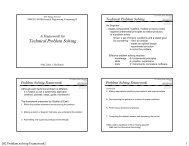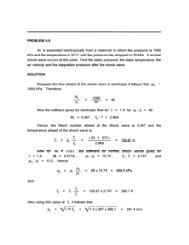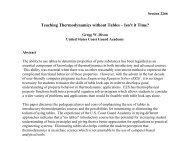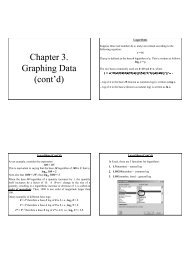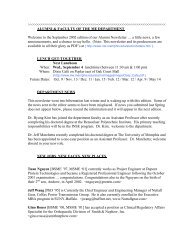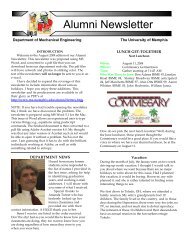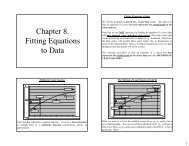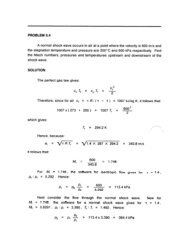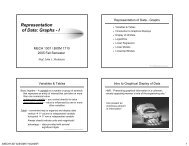MECHANICS of FLUIDS LABORATORY - Mechanical Engineering
MECHANICS of FLUIDS LABORATORY - Mechanical Engineering
MECHANICS of FLUIDS LABORATORY - Mechanical Engineering
Create successful ePaper yourself
Turn your PDF publications into a flip-book with our unique Google optimized e-Paper software.
EXPERIMENT 10<br />
DRAG FORCE DETERMINATION<br />
An object placed in a uniform flow is acted<br />
upon by various forces. The resultant <strong>of</strong> these<br />
forces can be resolved into two force components,<br />
parallel and perpendicular to the main flow<br />
direction. The component acting parallel to the<br />
flow is known as the drag force. It is a function <strong>of</strong><br />
a skin friction effect and an adverse pressure<br />
gradient. The component perpendicular to the<br />
flow direction is the lift force and is caused by a<br />
pressure distribution which results in a lower<br />
pressure acting over the top surface <strong>of</strong> the object<br />
than at the bottom. If the object is symmetric<br />
with respect to the flow direction, then the lift<br />
force will be zero and only a drag force will exist.<br />
Measurement <strong>of</strong> the drag force acting on an object<br />
immersed in the uniform flow <strong>of</strong> a fluid is the<br />
subject <strong>of</strong> this experiment.<br />
Equipment<br />
Subsonic Wind Tunnel<br />
Objects<br />
A description <strong>of</strong> a subsonic wind tunnel is<br />
given in Experiment 9 and is shown schematically<br />
in Figure 9.3. The fan at the end <strong>of</strong> the tunnel<br />
draws in air at the inlet. An object is mounted on a<br />
stand that is pre calibrated to read lift and drag<br />
forces exerted by the fluid on the object. A<br />
schematic <strong>of</strong> the test section is shown in Figure<br />
10.1. The velocity <strong>of</strong> the flow at the test section is<br />
also pre calibrated. The air velocity past the<br />
object can be controlled by changing the angle <strong>of</strong><br />
the inlet vanes located within the fan housing.<br />
Thus air velocity, lift force and drag force are<br />
read directly from the tunnel instrumentation.<br />
There are a number <strong>of</strong> objects that are<br />
available for use in the wind tunnel. These<br />
include a disk, a smooth surfaced sphere, a rough<br />
surface sphere, a hemisphere facing upstream,<br />
and a hemisphere facing downstream. For<br />
whichever is assigned, measure drag on the object<br />
as a function <strong>of</strong> velocity.<br />
Data on drag vs velocity are usually graphed<br />
in dimensionless terms. The drag force D f is<br />
customarily expressed in terms <strong>of</strong> the drag<br />
coefficient C D (a ratio <strong>of</strong> drag force to kinetic<br />
energy):<br />
in which ρ is the fluid density, V is the free<br />
stream velocity, and A is the projected frontal<br />
area <strong>of</strong> the object. Traditionally, the drag<br />
coefficient is graphed as a function <strong>of</strong> the<br />
Reynolds number, which is defined as<br />
Re = VD<br />
ν<br />
where D is a characteristic length <strong>of</strong> the object<br />
and ν is the kinematic viscosity <strong>of</strong> the fluid. For<br />
each object assigned, graph drag coefficient vs<br />
Reynolds number and compare your results to<br />
those published in texts. Use log-log paper if<br />
appropriate.<br />
Questions<br />
1. How does the mounting piece affect the<br />
readings?<br />
2. How do you plan to correct for its effect, if<br />
necessary?<br />
uniform flow<br />
lift force<br />
measurement<br />
object<br />
mounting stand<br />
drag force<br />
measurement<br />
FIGURE 10.1. Schematic <strong>of</strong> an object mounted in<br />
the test section <strong>of</strong> the wind tunnel.<br />
D f<br />
C D<br />
=<br />
ρV 2 A/2<br />
27



